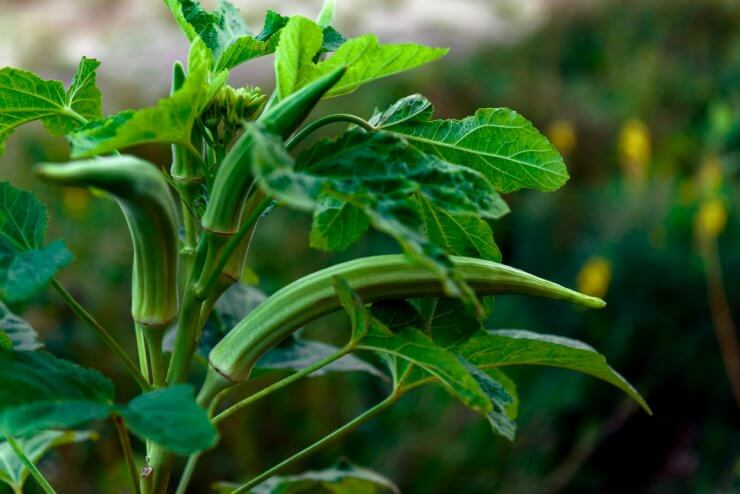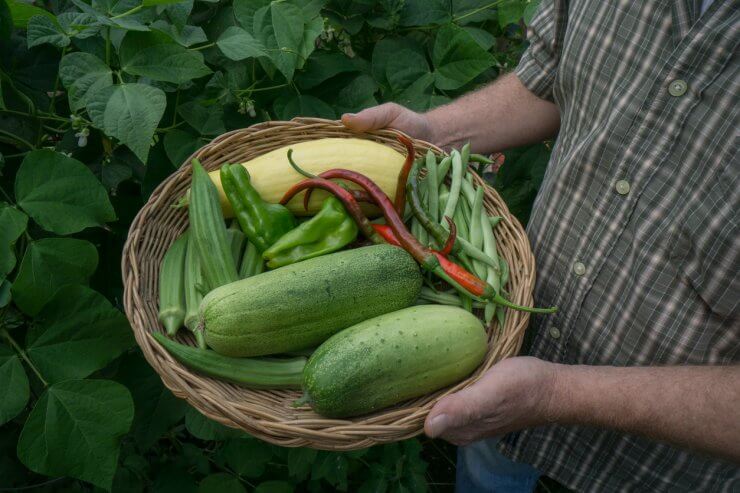
Gumbo, which translates to okra in Bantu, is not the only dish that can be enjoyed with okra, although it’s certainly the most popular one! More popular in southern cuisine, okra can be fried, eaten whole, dried; pickled; grilled; roasted; and of course, a staple in jambalaya and gumbo. If you’re considering growing your own, consider the best okra companion plants to go with them in your garden.
This delicious, versatile seed pod isn’t technically a vegetable at all, even though that’s the way we treat it. It’s the fruit of the plant—a pod packed with flavorful seeds that you don’t need to remove before eating. But you can use the seeds and press them for a rich oil that lends its flavor to homemade breads.

Okra is a warm-season crop, a member of the mallow family—which includes hibiscus and cotton. It’s easy to grow, versatile to cook with, and if you don’t manage to keep up with the harvest (it happens!), you can use the long, mature seed pods as decorations—and even for making paper and rope. Okra likes heat and humidity. If that’s what your summers are like, okra may be a good fit for you and your garden. Technically, though, you can grow okra in all USDA hardiness zones—with a little planning. All okra are what we call day-neutral. Their growth is not dependent on the length of the day in order to bloom and grow. They do still need a good 6-8 hours of sunlight a day, so pick your planting spot accordingly.
There are dozens of species of okra. The pods are either red or green, and when you cook the red pods, they usually turn green (unless they turn purple). No matter their color, though, they all have the same okra companion plants, check them out below!

Okra Companion Plants
Companions plants benefit each other in one or many ways. So for example, you might plant carrots with onions, because the scent of the onions keeps carrot flies away. In other cases, you might plant two together that don’t fight for the same nutrients, like tomatoes and corn. And some benefit simply on flavor – small studies have shown that basil makes tomatoes taste better.
As for okra, you can definitely make your okra patch do double duty by adding some okra companion plants.
- Plants with shallow roots, like lettuce, can do well with okra; okra’s big leaves can shade the tender lettuce plants from too much sun.
- Herbs are another good choice: basil, parsley, tarragon, and cilantro will appreciate the filtered sunlight. And the scent of basil near your okra will repel some pests, including flea beetles, aphids, stink bugs, and spider mites.
- Spring crops, like peas, make a good planting companion for okra; you can plant them in the same rows. If you plant snow peas, for example, that harvest will be in before the okra even notice the peas were there. Once you harvest the peas, pull up the remaining plants to turn all the growing space over to the okra plants.
- Radishes and peppers are other good companion plants. The radishes come with a bonus feature: radish seedlings loosen the soil as they grow, creating more growing space for your okra.
- If you want to add a burst of color to your okra garden and attract pollinators (especially if you’re growing heirloom plants), consider flowers like cosmos and zinnia. And, of course, marigolds are always a welcome addition to almost any garden (and they’re edible, too!).
- Sunflowers make great companions, too, adding a burst of color while attracting pollinators to your okra plants.
Learn How to Grow Okra at Home
Okra is a highly versatile, incredibly prolific plant that can grow almost anywhere that has lots of sun. From containers on balconies to open fields of freestanding plants, there’s okra that you can grow. It’s delicious raw or cooked! Come check out Pick a Perfect Pod: The Guide to Growing Okra. With this gardening guide, you get the low down on growing your own okra. We’ve got everything from the history of okra to planting to picking and storing and, of course, eating. You’ll want to check out our recipes for everything from chips to pickles and jambalaya to gumbo. These recipes make it all the more rewarding to grow your own okra. Finally, learn about nutritional benefits to help improve your health. Get it all in this Pick a Perfect Pod: The Guide to Growing Okra right now!
What are your favorite okra companion plants? Leave a comment below.


 Previous
Previous

